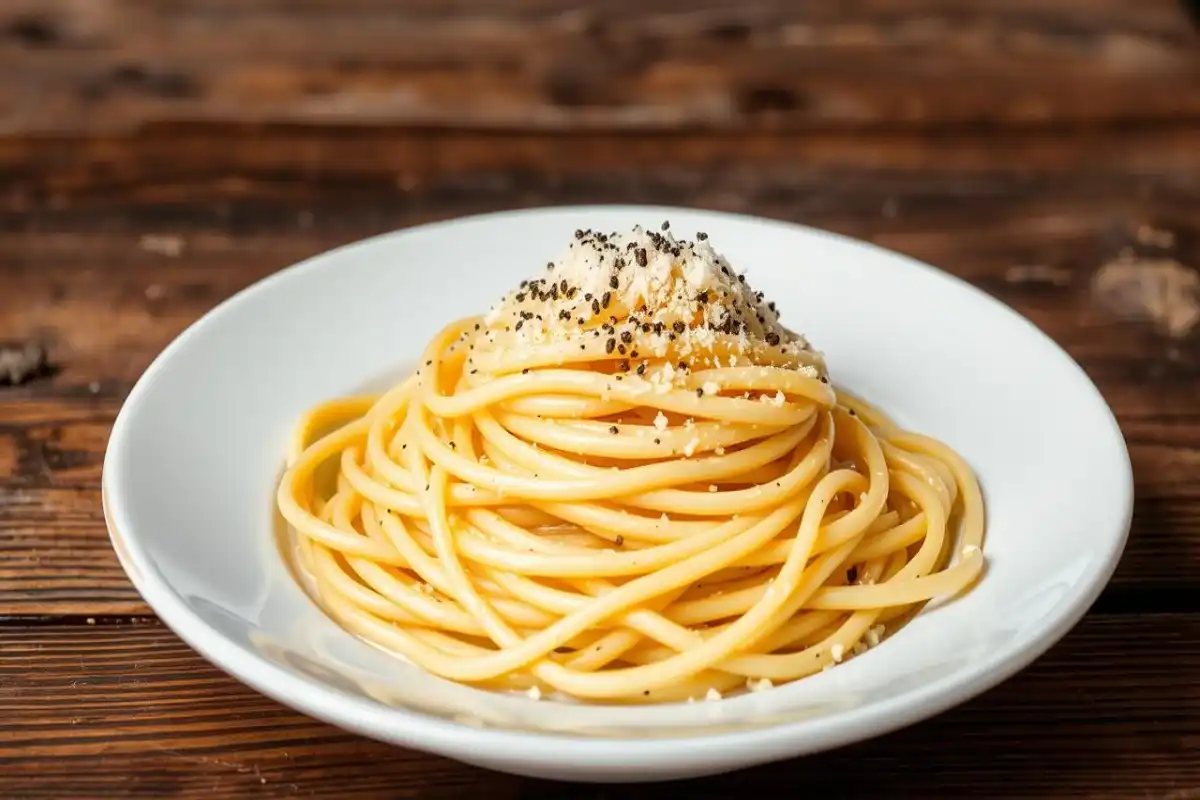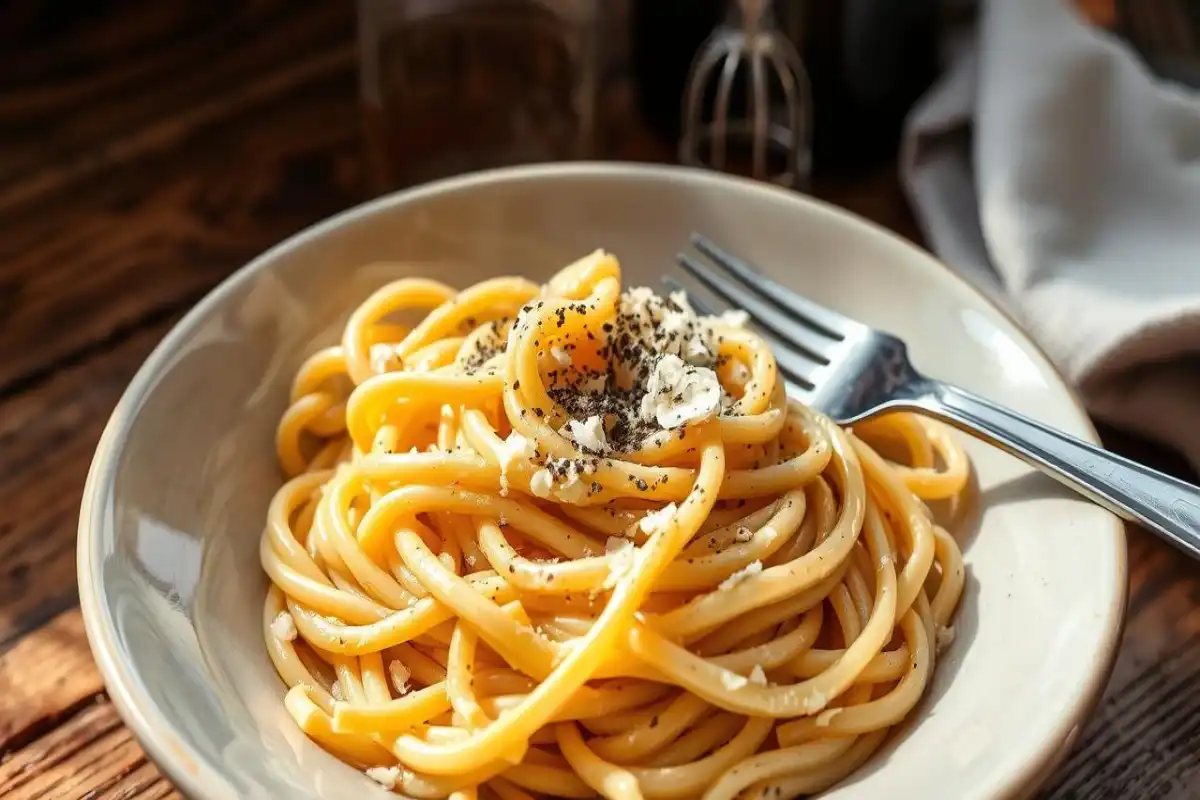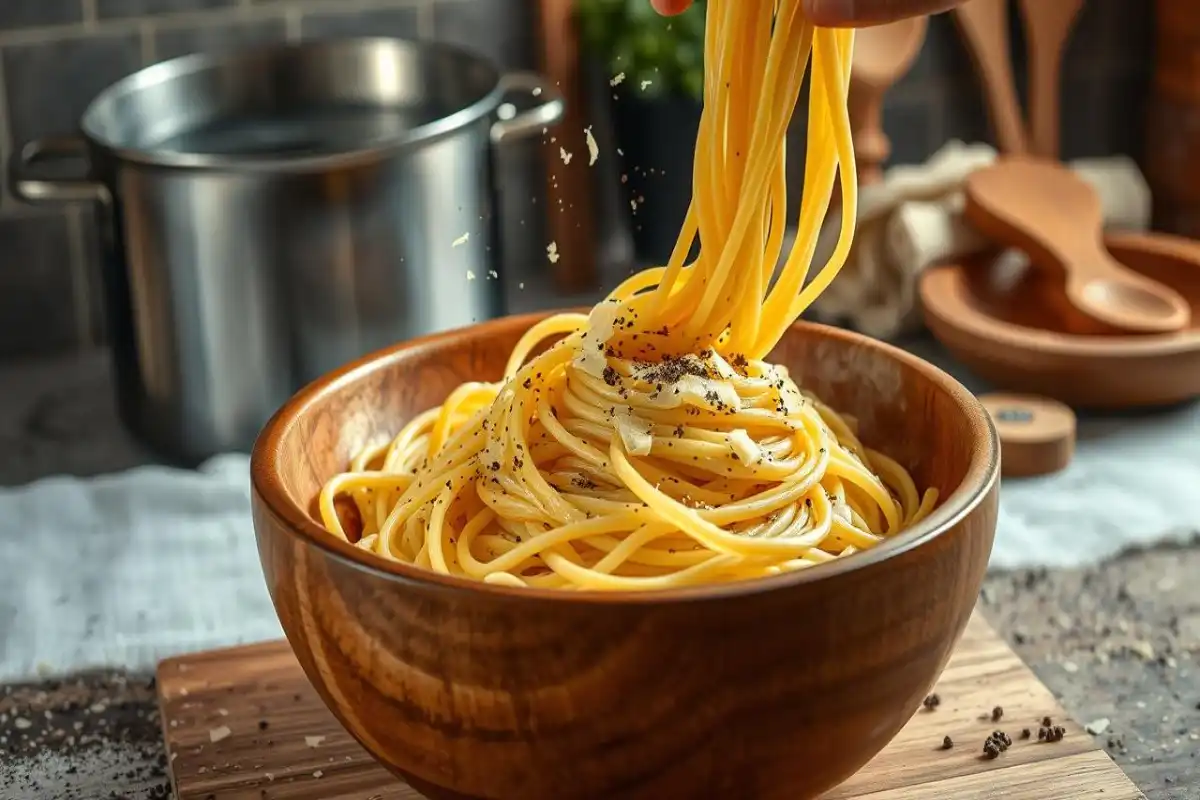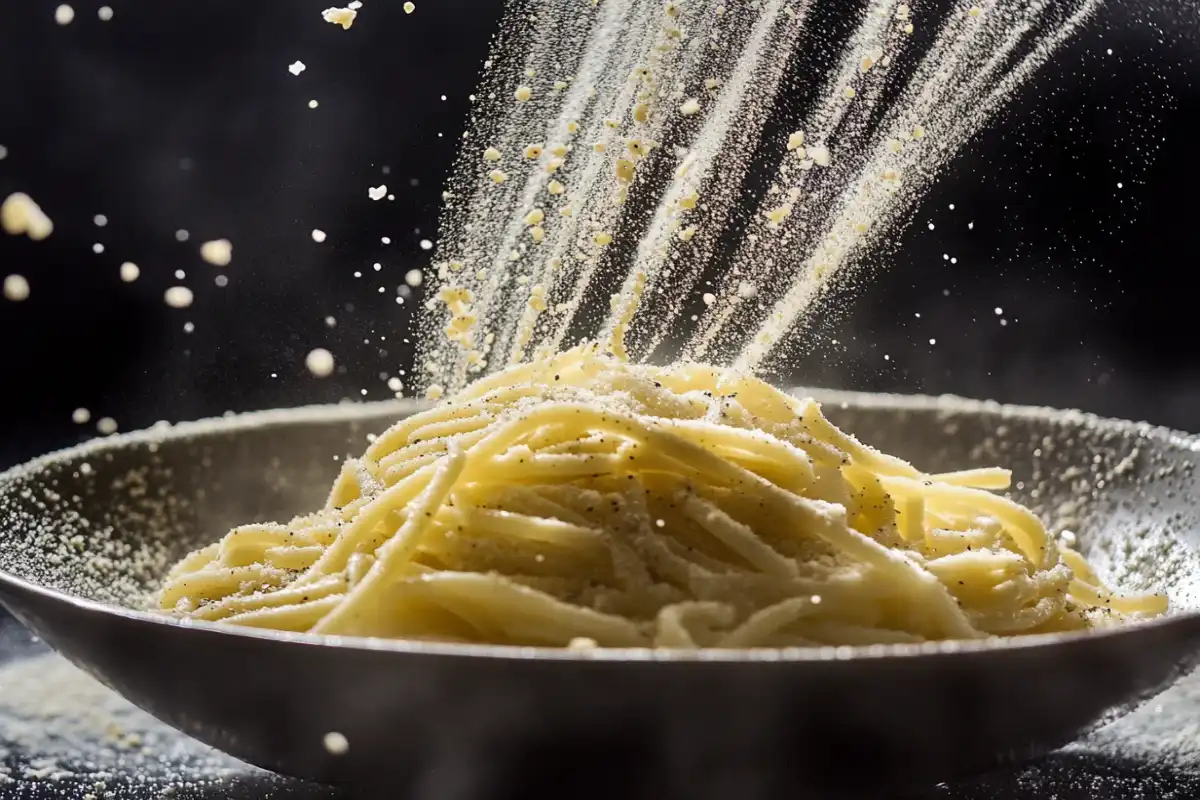Cacio e pepe, a famous Roman pasta dish, is known for its simplicity but is hard to perfect. It has just a few ingredients: bucatini pasta, Pecorino Romano cheese, and black pepper. To get the creamy, peppery sauce right, you need to master a specific technique.
The sauce’s success depends on mixing the cheese and pasta water just right. This process needs patience and skill. If you mess up, the sauce can become too thick, too thin, or just wrong.

Key Takeaways
- Cacio e pepe is a deceptively simple Roman pasta dish that is notoriously challenging to execute perfectly.
- The key to a successful cacio e pepe lies in the precise technique required to create the signature creamy, peppery sauce.
- Mastering the delicate balance of flavors and textures, particularly the emulsion of cheese and pasta water, is critical for achieving the dish’s signature texture.
- Overcooking or undercooking the pasta, using the wrong type of cheese, or mistiming the additions can easily ruin the dish.
- Attention to detail and a deep understanding of the pasta-making technique are essential for nailing the perfect cacio e pepe.
Bucatini Cacio e Pepe: The Iconic Roman Sheep Herder’s Pasta
Cacio e pepe, or “cheese and pepper,” is a traditional Roman pasta dish. It has ancient roots and was once a simple meal for sheep herders in the Italian countryside. Now, this bucatini pasta is known worldwide for its bold flavors and simple elegance.
The Roman pasta dish of cacio e pepe shows the beauty of using just a few top-quality ingredients. The main parts are bucatini (a thick, hollow spaghetti-like pasta), Pecorino Romano cheese, and fresh black pepper. Together, they make a dish that’s both comforting and classy.
“Cacio e pepe is the ultimate expression of the sheep herder’s dish – a rustic, uncomplicated meal that has become a culinary icon.”
The dish’s roots are in Lazio’s pastoral areas, where shepherds made it with what they had. Now, cacio e pepe is a beloved part of Roman cuisine. It highlights the city’s rich food history.

Today, cacio e pepe is famous for turning simple ingredients into a masterpiece. Its lasting popularity shows the charm of simplicity and the magic of traditional cooking.
Mastering the Art of Cacio e Pepe
Learning to make cacio e pepe is all about mastering the cooking technique. It’s about adding pasta water at the right time and balancing flavors and textures. Each step is important to make this dish, which may seem simple but is actually complex.
The Importance of Technique
The secret to a great cacio e pepe is in the cooking method. The pasta should be al dente, and the cheese sauce should be creamy. It’s all about stirring, tossing, and adding pasta water to mix everything perfectly.
Balancing Flavors and Textures
The magic of cacio e pepe is in its balance. The Pecorino Romano cheese and black pepper must work together. It’s a delicate balance of salty, peppery, and creamy. Getting it just right is the challenge.
| Key Factors for Mastering Cacio e Pepe | Importance |
|---|---|
| Cacio e pepe technique | Precise timing and execution of adding pasta water to the cheese is crucial for creating a creamy, emulsified sauce. |
| Pasta cooking method | Cooking the pasta al dente ensures the proper texture and bite to complement the rich cheese sauce. |
| Cheese sauce emulsion | A well-emulsified cheese sauce is the hallmark of a perfectly executed cacio e pepe, with a velvety, creamy consistency. |
| Flavor balance | Striking the right balance between the salty Pecorino Romano and the robust black pepper is crucial for creating a harmonious dish. |
To master cacio e pepe, you need to understand these key elements. It takes patience and precision. With practice, anyone can become skilled in making this iconic Roman dish.

The Simplicity that Belies Complexity
Cacio e pepe seems simple at first glance. It only needs pasta, Pecorino Romano cheese, black pepper, and pasta water. But, making it well is a real challenge. It’s seen as a true test of a chef’s abilities.
The secret to cacio e pepe is in the pasta technique. Mixing cheese and pasta water just right is tricky. Too much water makes it too wet, too little makes it dry.
Also, the quality of ingredients matters a lot. Good Pecorino Romano cheese is key for its creamy taste. The pasta shape, like bucatini or spaghetti, also affects the dish’s feel and how the sauce sticks.
Cacio e pepe is not as easy as it looks. It needs skill in pasta making, a good taste, and attention to detail. Mastering cacio e pepe shows a chef’s talent and hard work. They balance flavors and textures to make this famous Roman dish.
Choosing the Right Ingredients
The success of cacio e pepe depends on its ingredients. Artisanal Pecorino Romano cheese and high-quality pasta are key. They give the dish its unique flavor and texture.
Artisanal Pecorino Romano
Pecorino Romano cheese is the heart of cacio e pepe. It’s made from sheep’s milk in Italy’s Lazio region. Look for artisanal Pecorino Romano for its salty, tangy, and umami flavor.
High-Quality Pasta
The pasta used in cacio e pepe matters too. Traditionally, bucatini or spaghetti are used. Choose a high-quality, dried pasta with a rough surface. This helps trap the sauce and blend flavors well.
| Ingredient | Importance |
|---|---|
| Pecorino Romano Cheese | Provides the dish with its signature salty, tangy, and umami-rich flavor profile. |
| High-Quality Pasta | Ensures the pasta can effectively hold and blend with the cacio e pepe ingredients. |
By choosing the best pecorino romano and pasta, home cooks can make a delicious cacio e pepe. This ensures a true and tasty dining experience.
The Elusive Creaminess
Getting the perfect cacio e pepe creaminess is a big goal for pasta lovers and chefs. This classic Roman dish seems simple, but making the cheese and pasta water mix into a smooth sauce is hard. It’s a real challenge.
Emulsifying Cheese and Pasta Water
The secret to cacio e pepe creaminess is finding the right mix of cheese and pasta water. When done right, they turn into a smooth sauce that wraps around the pasta. This gives a rich feel and strong taste.
The science behind it is cool. The hot pasta water and grated Pecorino Romano cheese mix up, making a creamy sauce. But, getting it just right needs careful timing, temperature, and a light touch. This prevents the cheese from clumping or the sauce from getting too thick.
Knowing how to do this makes all the difference. A good cacio e pepe has a smooth, rich sauce that sticks to the pasta. It brings together a mix of flavors in every bite.
Timing is Everything
Making the perfect cacio e pepe needs careful timing. It’s about cooking the pasta right and adding the cheese at just the right moment. This dish shows that simplicity can be powerful, but it needs a skilled touch.
The pasta cooking time is key. Bucatini, the noodles used, must be cooked just right. If it’s overcooked, it becomes mushy. If it’s undercooked, it’s too hard.
Adding the cheese is another critical step. The Pecorino Romano cheese must be added when the pasta is hot. This creates a smooth sauce that sticks to the pasta.
- Cook the pasta until it’s al dente, about 1-2 minutes less than the package says.
- Save a cup of pasta water before draining the noodles.
- Immediately mix the hot pasta with grated Pecorino Romano cheese and some pasta water.
- Stir well until the cheese melts and the sauce becomes creamy.
- Finish with a lot of black pepper and adjust the seasoning as needed.
The cacio e pepe timing is all about balance. With practice, anyone can make this dish shine. It’s about finding the right mix of simplicity and complexity.
| Step | Timing | Purpose |
|---|---|---|
| Cook the pasta | 1-2 minutes less than package instructions | Achieve the desired al dente texture |
| Reserve pasta cooking water | Before draining the noodles | Use the starchy water to emulsify the cheese |
| Toss the pasta with cheese | Immediately after draining | Allow the cheese to melt and form a creamy sauce |
“The secret to a perfect cacio e pepe lies in the timing of each step, from the pasta to the cheese. It’s a delicate balance that can make or break the dish.”
The Pitfalls of Overcooking and Undercooking
Making the perfect cacio e pepe is a delicate task. It’s especially true when cooking the pasta. If you overcook or undercook the noodles, the dish can fail. This ruins the al dente texture that makes cacio e pepe special.
Achieving al Dente Perfection
The secret to great cacio e pepe pasta is cooking it just right. If it’s overcooked, it becomes mushy and unappealing. On the other hand, undercooked pasta is hard and unpleasant to eat. To get the perfect al dente, watch the cooking time closely and test the pasta often.
Here are some tips for perfect al dente pasta in your cacio e pepe:
- Choose high-quality, artisanal pasta like bucatini. It keeps its shape and texture well.
- Cook the pasta in salted boiling water, stirring now and then, until it’s tender but still firm.
- Check the pasta by biting into it. It should feel slightly resistant with a creamy center.
- Drain the pasta immediately when it’s al dente to avoid overcooking.
By learning to cook pasta to the perfect al dente, you’ll make a cacio e pepe that’s balanced. It will have the right mix of cacio e pepe overcooking, undercooking, and al dente pasta textures.
Variations and Twists on the Classic
The traditional cacio e pepe recipe is loved by many. But, chefs have been trying new things with this classic Roman dish. They show how cacio e pepe can be made in many ways, proving it’s a dish that can always be reinvented.
One new version is cacio e pepe bianco, which uses white pepper instead of black. This gives it a softer, more complex taste. Others add lemon zest for a hint of citrus. Some even add pancetta or guanciale for a richer flavor.
Chefs have also put cacio e pepe in new dishes like cacio e pepe risotto or cacio e pepe pizza. These ideas show how the traditional cacio e pepe recipe can be updated while keeping its essence.
The main aim is to keep the dish simple yet indulgent. The charm of cacio e pepe is in its ability to please with just a few ingredients and a chef’s skill.
“The beauty of cacio e pepe is its ability to be both traditional and innovative. It’s a canvas for chefs to explore and express their creativity while honoring the beloved flavors of the past.”
Cacio e Pepe: A Roman Masterpiece
The cacio e pepe dish is a true culinary gem. It has been loved for years, showing that simplicity can be powerful in food. This Roman favorite, with its simplicity of cacio e pepe, wins hearts everywhere.
The Enduring Appeal of Simplicity
Cacio e pepe proves that simple dishes can be the most amazing. It’s a lesson in less is more. This classic Roman dish lets its ingredients speak for themselves, without fancy tricks.
The dish’s charm comes from its simplicity. It lets you enjoy the salty cheese and peppery taste. This balance has won over many food lovers, who see beauty in its straightforwardness.
Cacio e pepe takes you back to Rome’s streets, where it was born. It’s a dish that connects us to tradition and elegance. Its popularity worldwide has made it a true Roman masterpiece.
Tips and Tricks for Nailing Cacio e Pepe
Learning to make cacio e pepe at home is a fun challenge. Start with top-notch pecorino Romano cheese. It’s the heart of this classic Roman dish. Grate the cheese finely so it melts well into the pasta water, making a smooth sauce.
Timing is key when making cacio e pepe. Cook the pasta until it’s al dente. Save a lot of the starchy cooking water. This water helps mix the cheese with the pasta, making a creamy sauce.
Use the right pasta for cacio e pepe. Bucatini is the traditional choice, but you can try spaghetti or linguine too. Cook the pasta until it’s just right, not too hard or too soft. This ensures a perfect dish.
FAQ
What makes cacio e pepe so challenging to execute perfectly?
Cacio e pepe is a simple yet tricky Roman pasta dish. It requires precise cooking and balancing flavors and textures. Getting the creamy, peppery sauce just right is key.
What are the origins of the iconic Roman dish, bucatini cacio e pepe?
Cacio e pepe, or “cheese and pepper,” has ancient roots. It started as a simple meal for sheep herders in Italy. Now, it’s loved worldwide for its bold flavors and simplicity.
What are the most important elements to master when making cacio e pepe?
To perfect cacio e pepe, you need to understand cooking techniques. This includes adding pasta water to cheese at the right time. It’s a test of a chef’s skills.
Why does the simplicity of cacio e pepe belie its complexity?
Cacio e pepe seems easy with just a few ingredients. But, making it well is complex. This makes it a true challenge for chefs.
What are the key ingredients that are essential for making the perfect cacio e pepe?
Quality ingredients are crucial for cacio e pepe. You need artisanal Pecorino Romano cheese and good pasta. They’re key to the dish’s flavor and texture.
How do you achieve the elusive creamy texture in cacio e pepe?
Getting the creamy texture in cacio e pepe is a skill. You must mix the cheese and pasta water right. This step is vital for the dish’s success.
Why is timing so important when making cacio e pepe?
Timing is everything in cacio e pepe. It affects the dish’s flavors and textures. Getting it right is crucial.
What are the common pitfalls of overcooking and undercooking when making cacio e pepe?
Cooking pasta just right is key. Overcooking makes it mushy, while undercooking makes it tough. Both ruin the dish.
What are some of the modern interpretations and variations of the classic cacio e pepe recipe?
Chefs have put their own spin on cacio e pepe. They keep the traditional flavors but add new twists. These versions are creative and delicious.
What is the enduring appeal of the simplicity of cacio e pepe?
Cacio e pepe’s simplicity has made it a timeless favorite. It shows the beauty of quality ingredients. This simplicity captivates diners everywhere.
What are some tips and tricks for nailing the perfect cacio e pepe at home?
Making cacio e pepe at home can be tough. But, with the right techniques and ingredients, you can get it just right. Here are some tips for perfecting this iconic dish.
